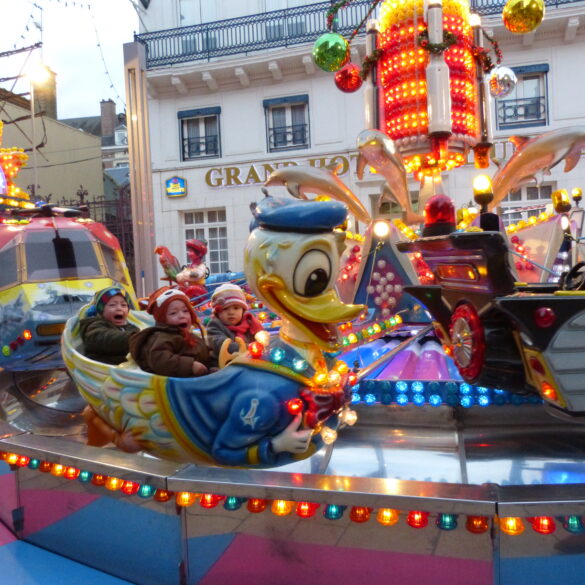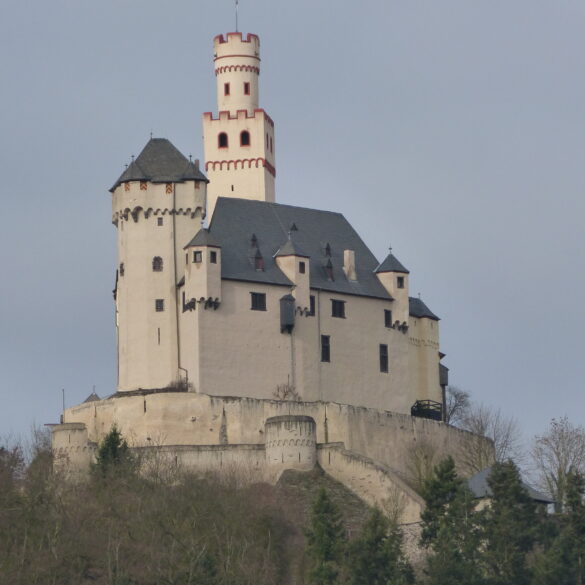Lorsch & Maulbronn UNESCO Sites, DE
After we visited Amiens, France a couple of weeks ago and realized that the cathedral there is a UNESCO World Heritage Site, I went on the UNESCO website to see which other sites I had visited. Turns out I’ve been to about 50 of them without even trying, so I checked out some sites we could easily visit in the future. If you’re interested in reading more about UNESCO sites, you can view their website here http://whc.unesco.org/en/list/ The list is broken down by country.
I noticed that there is a site in Lorsch, Germany, which is only about a 45-minute drive for us. So on the Saturday after our trip to Amiens, we drove to Lorsch to the UNESCO site there, a former abbey.
As we were walking towards the site after parking the car, my heart started to sink a little after seeing this.
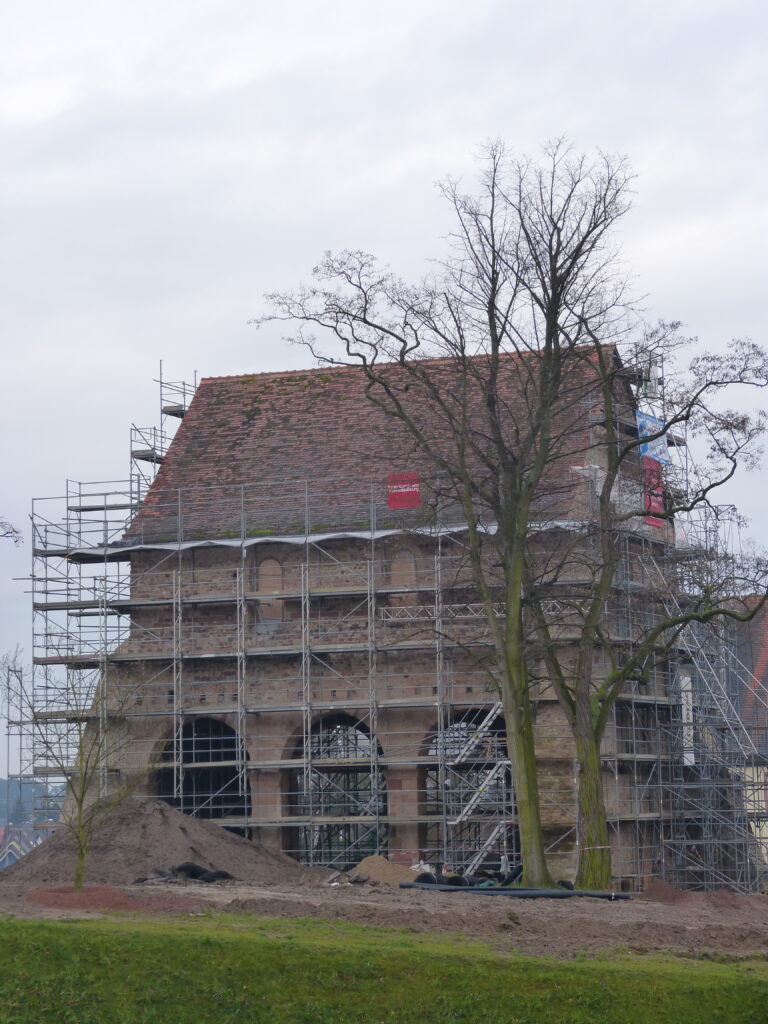
And then it sank even more when I saw this, the gatehouse for the abbey.
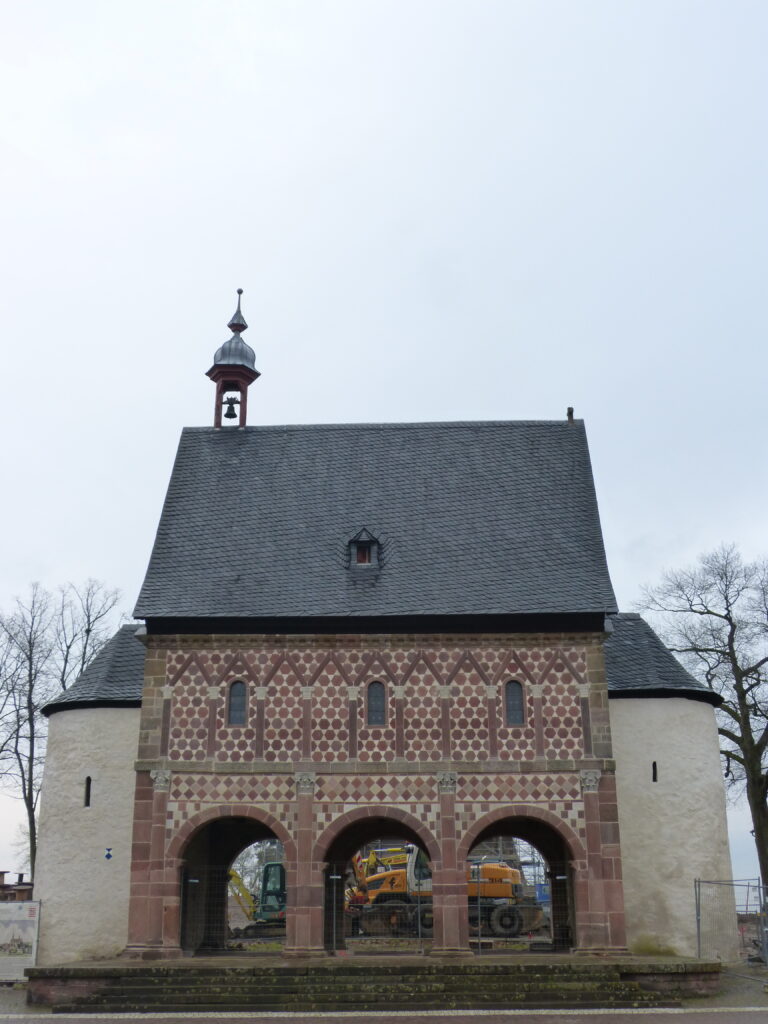
Notice the fencing and the construction vehicles.
Yes, it turned out that the whole site was under construction and closed. The museum was open, though, and although we didn’t visit it we went it to ask about the site. They told us it would probably re-open somewhere around the July timeframe. Luckily it’s a short drive for us, so we can go back another time.
We figured as long as we were in Lorsch we’d check out the town, so we went to the Tourist Information (TI) office.
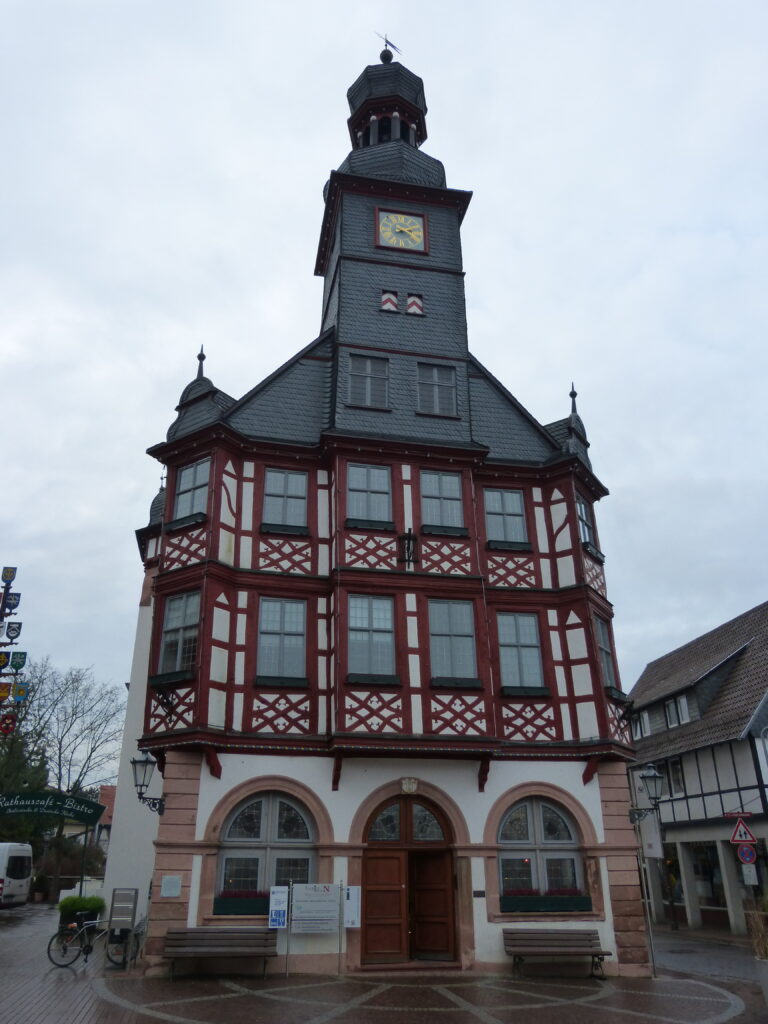
Pretty nice building for a TI, huh? It used to be the town hall (Rathaus in German) and it was built in 1715.
We asked in the TI whether they had a walking map tour and they did give us a map, but there was no tour or any other information about things in town. The woman who gave us the map basically told us there wasn’t much to see other than the UNESCO site. Methinks they might need a little lesson in PR, but we figured we’d walk around anyway.
There were some very nice, historic buildings right in the same area as the TI.
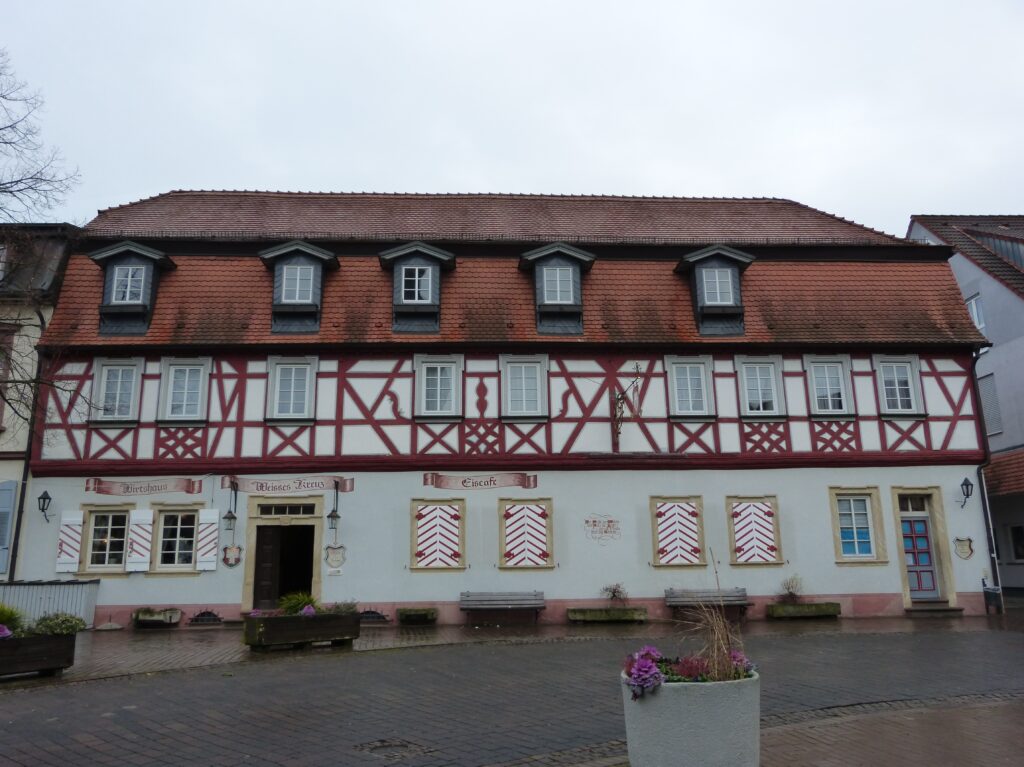
I had to take photos of the signs on the historic buildings, which were all in German, so I could translate them when I got home. I understand enough basic German to get the gist of what things were, but not enough to understand every word.
The building above was first mentioned in records in 1563 and was a convent inn, just down the street from the abbey. It was transferred to private ownership at the end of the 17th century and was renovated in the 1990s.
This building was a pharmacy built in 1717.
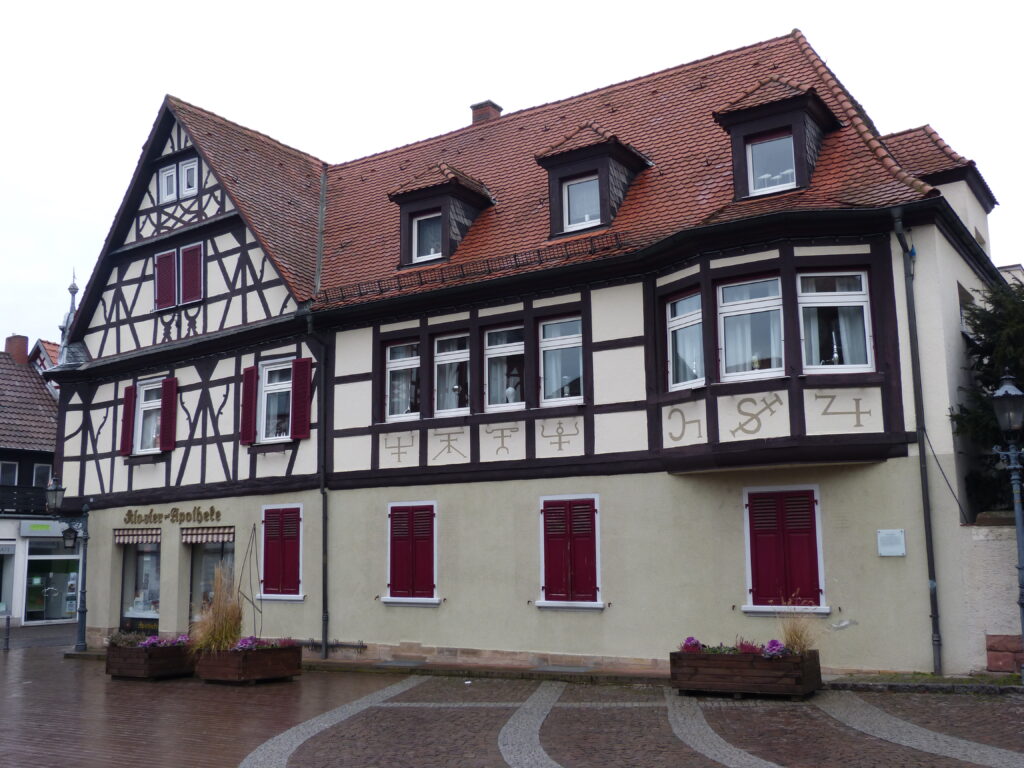
From what I can gather, the symbols under the windows represent different chemical elements such as copper, lead and mercury.
This fountain (obviously not running at the time we visited) in front of the old town hall was created in 1991.
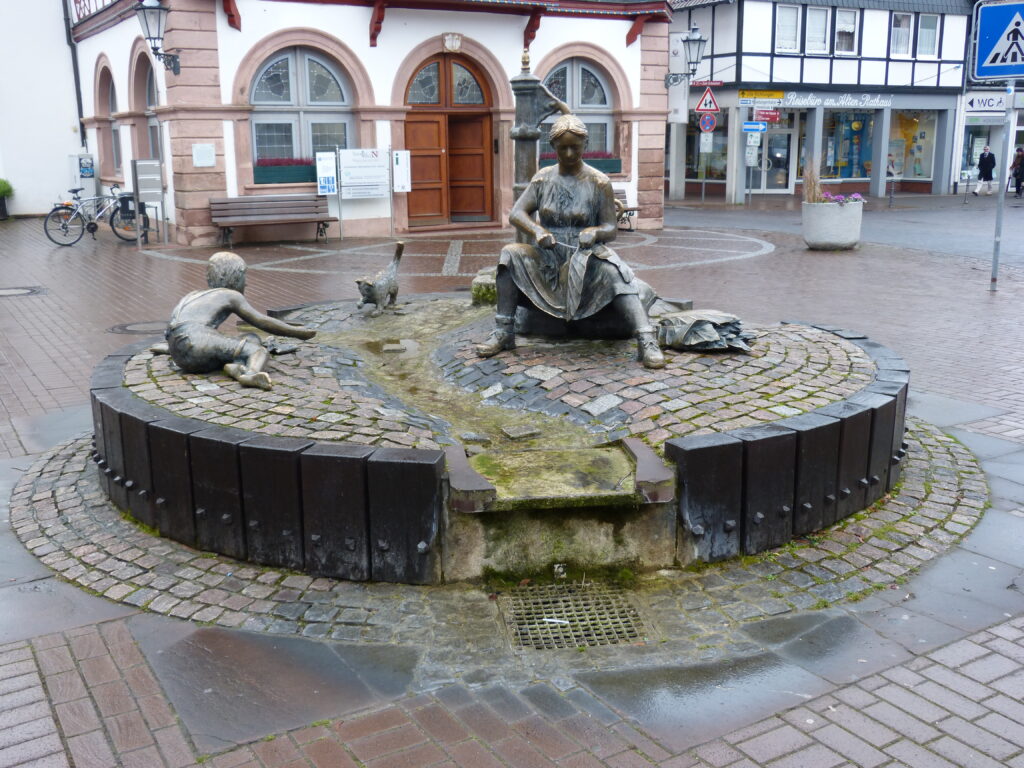
Tobacco processing was a big industry in Lorsch for a few hundred years and this fountain depicts a “tobacco seamstress”. I had never heard of this occupation before but apparently tobacco leaves would get sewn together and then hung up to dry and cure. I love learning new stuff like this.
Here is a common sight in Germany.
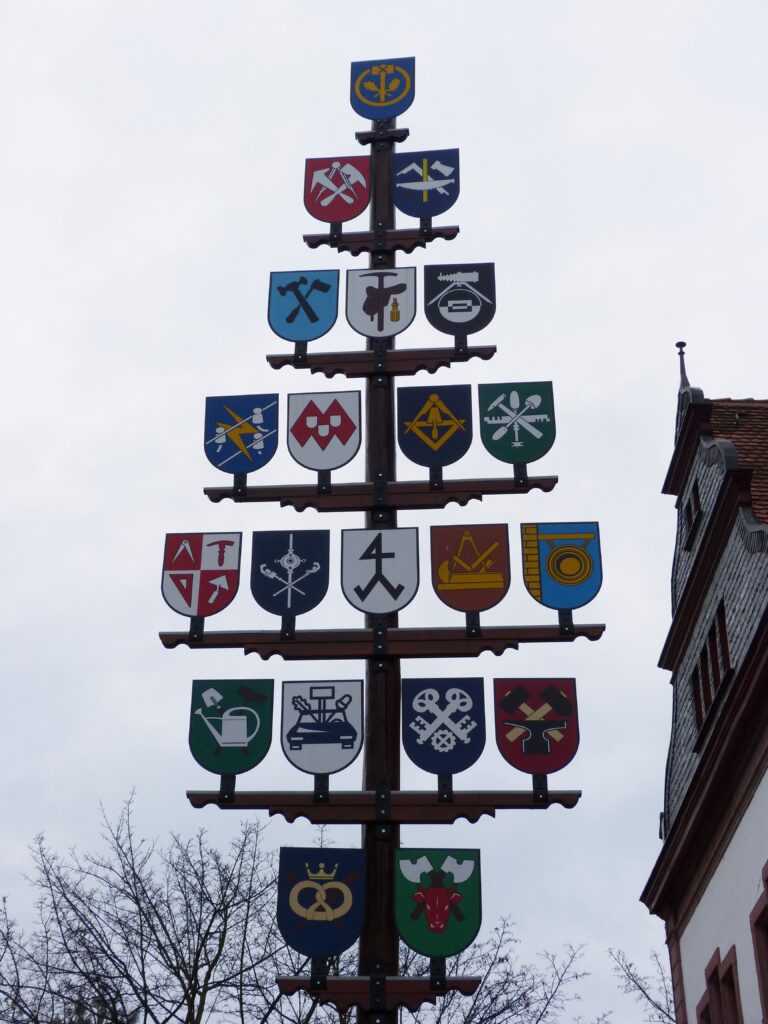
The signs on the pole represent different craftsmen guilds. For example, the sign on the lower left with the pretzel is the sign for the bakers guild and the on the lower right is for the butchers guild.
We came across the Saint Nazarius Catholic church on our walk.
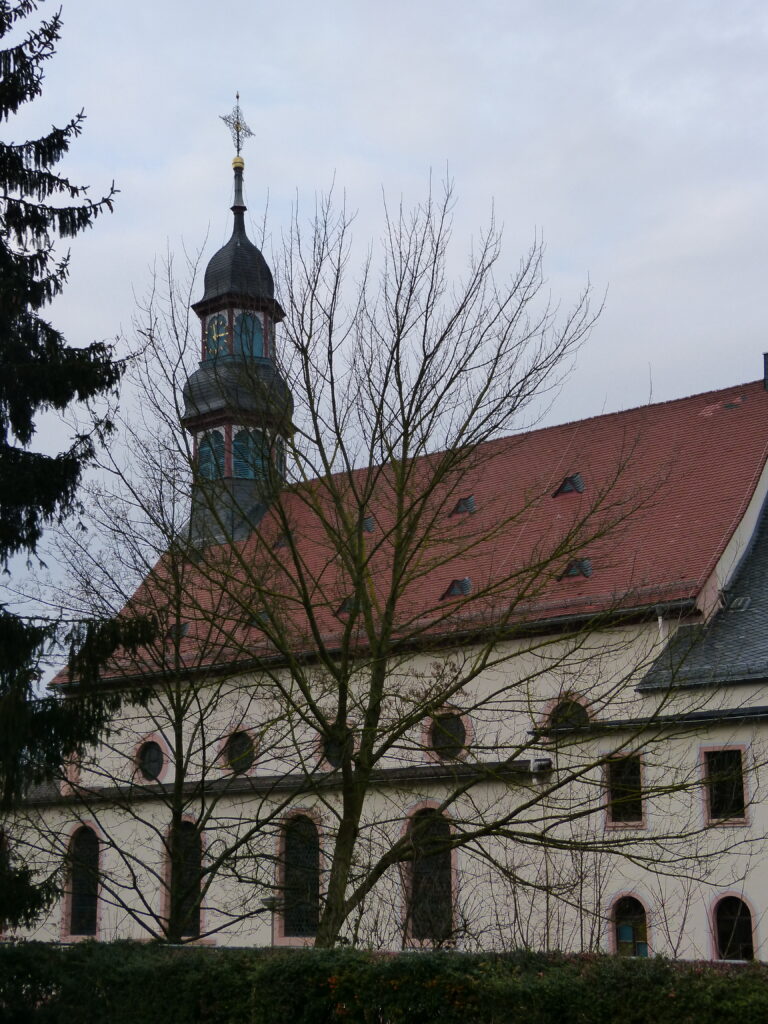
The church was built in 1726.
This building housed a bank that was founded in 1835.
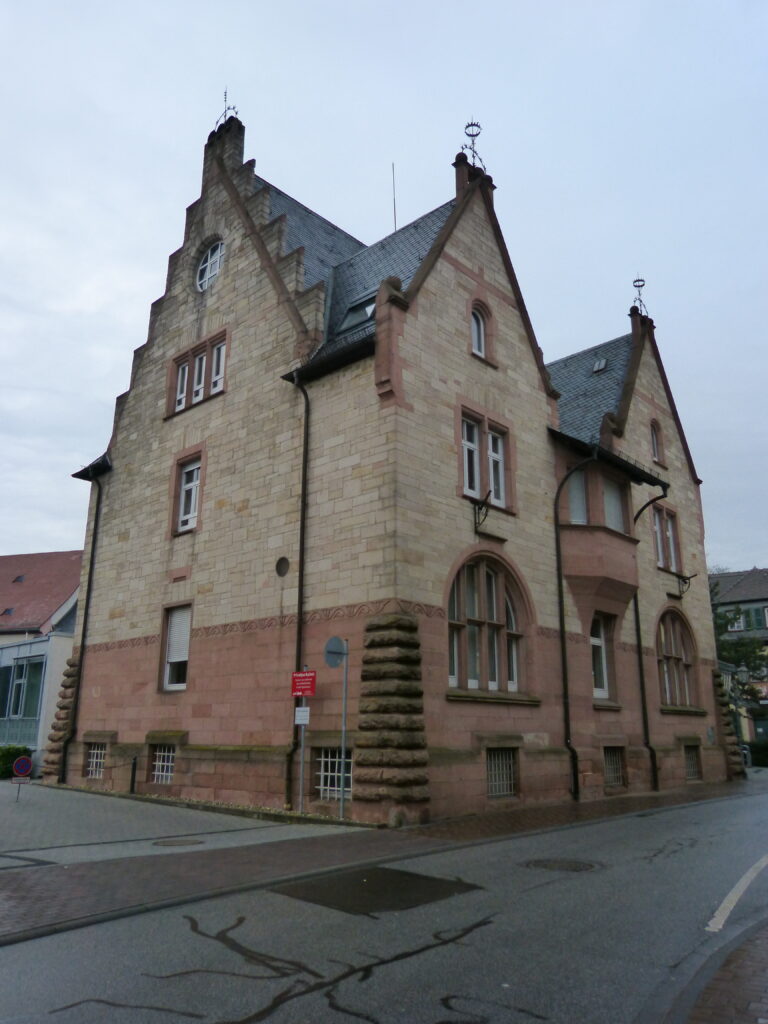
It seems that this building was erected around the year 1900 though, and it still houses a bank. The sign says it’s one of the most distinctive buildings in Lorsch. Personally I think the building that houses the TI is more distinctive but what do I know.
The monument here had an inscription that translates to “Dedicated to the brave warriors of Lorsch.”
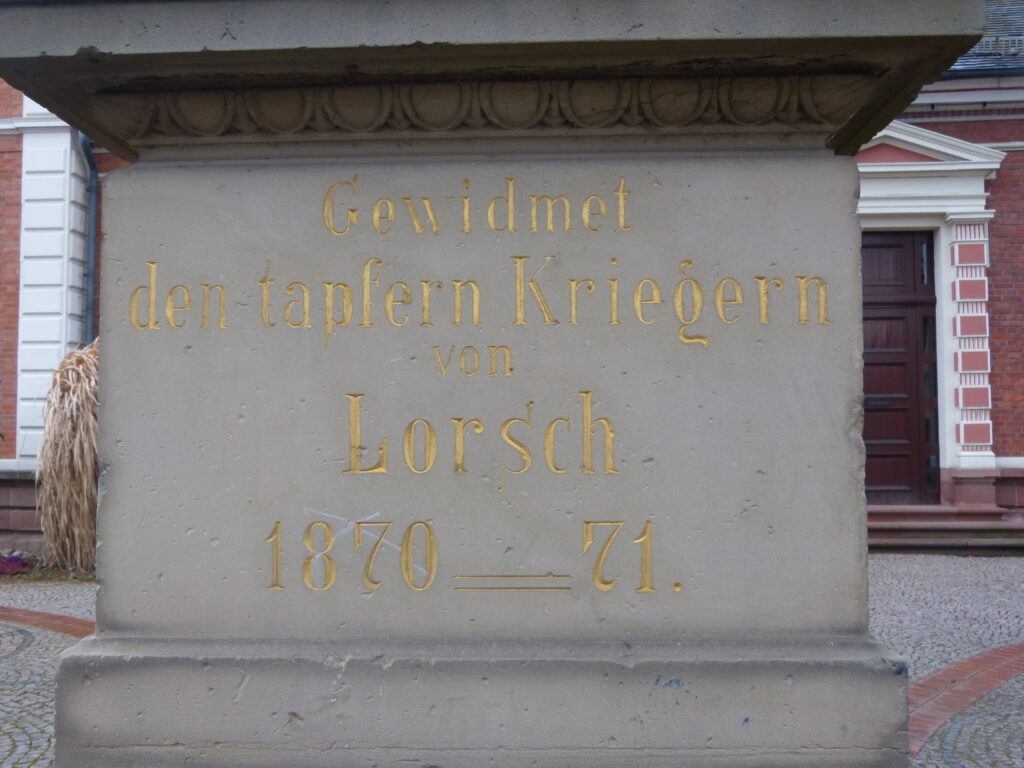
The date on the monument was 1870 – 71, which were the dates of the Franco-Prussian war.
The next building was built in 1879 and was formerly a courthouse.
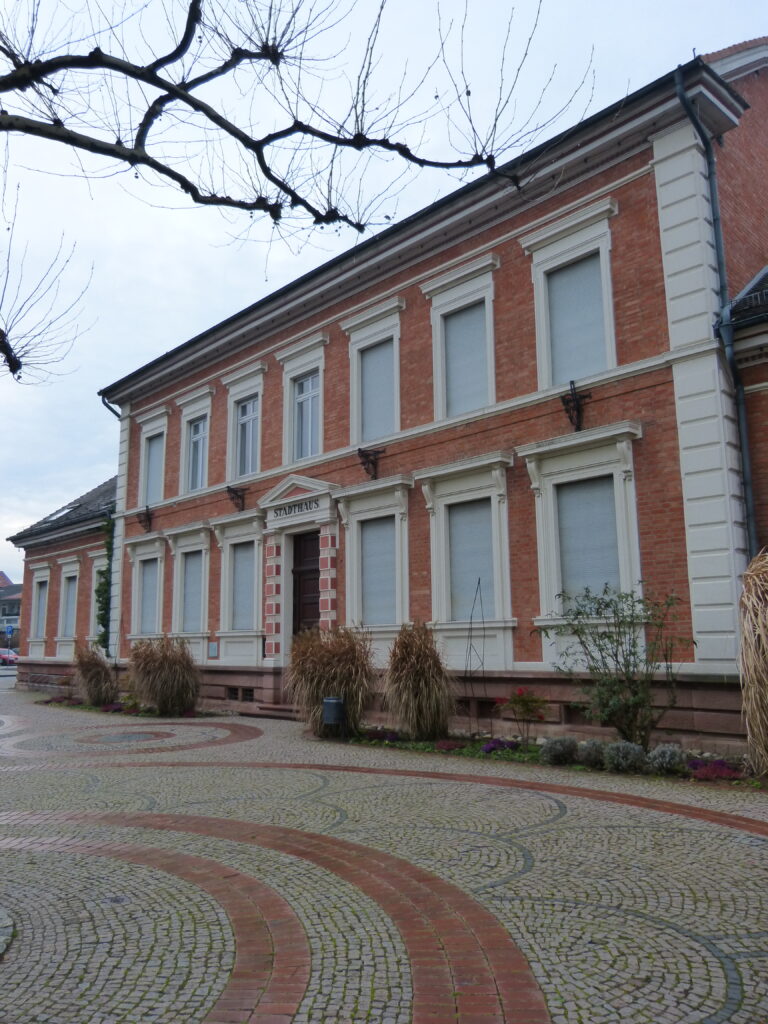
After the court relocated to another town in 1934, the building served various purposes. It was remodeled in 1979 and is now a town house (like a town hall).
This sculpture depicts a scene from a famous German epic poem called the Nibelungenlied.
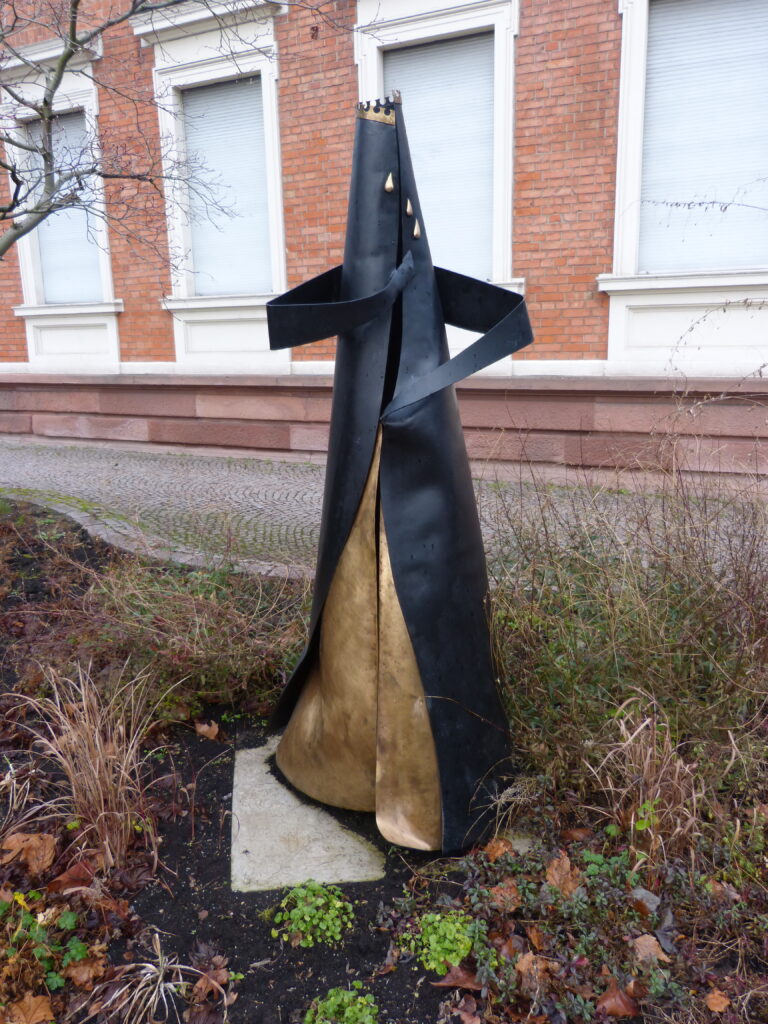
I had actually downloaded a translation of the story quite a while ago and read probably ¾ of it but never finished it. It tells the tale of a hero named Siegfried who, among other things, killed a dragon. He bathed in the dragon’s blood, which made him immune to harm. However, there was one spot that the dragon’s blood missed because Siegfried had a leaf stuck to his back. He end ups being killed (sorry, I guess I should have said there was a spoiler in case you ever want to read it) when he is speared in that vulnerable spot. The rest of the story is about Siegfried’s wife Kriemhild taking revenge for the murder. The sculpture you saw above represents the moment Kriemhild learns of Siegfried’s death. (Much of the story takes place in the area of Worms, which is very close to Lorsch.)
The Nibelungenlied was written somewhere around the year 1200, so the 800th anniversary was celebrated in the year 2000. Part of the celebration included sculptures being installed along what’s called the Nibelung-Siegfried Route. It’s actually two routes – the Nibelung Route and the Siegfried Route – that make up a circuit that begins in Worms. It starts out as onne route and then splits in Lorsch. There is information about the Nibelung in the Lorsch Abbey, but as you saw at the beginning of this post, the abbey was unfortunately closed.
This sign tells of sort of a sad event.
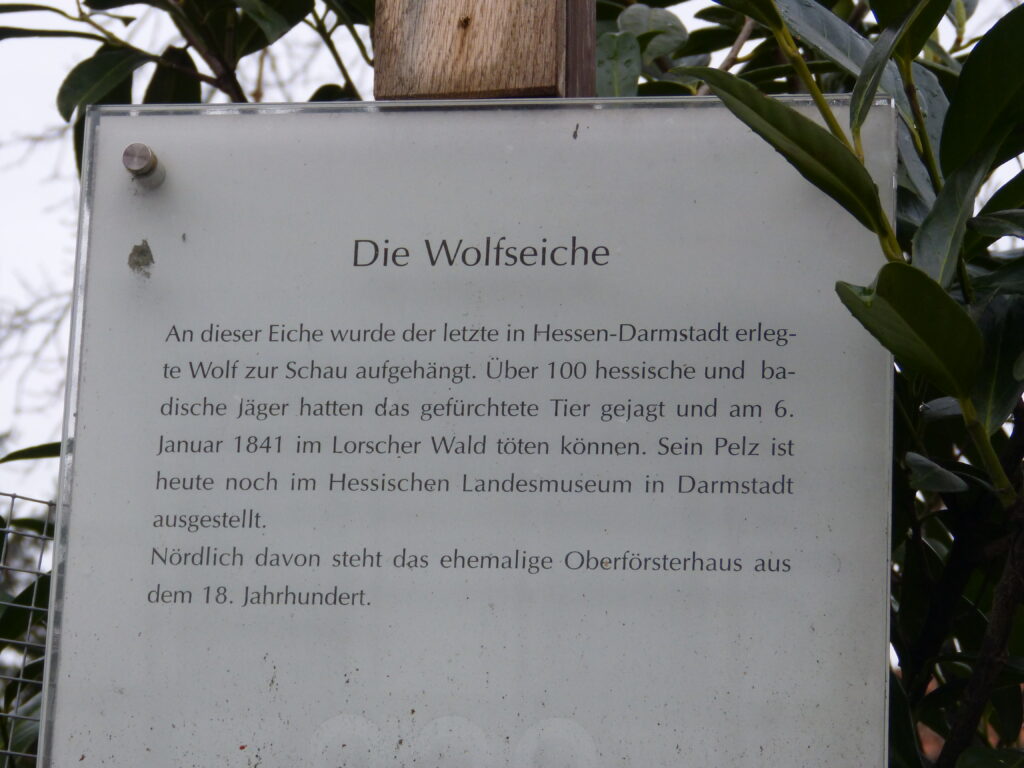
It says that on that oak tree, the last wolf killed in the area (in 1841) was hung on display. Its fur is still on display now, but in a museum in nearby Darmstadt. The sign also says that the house of the former head forester, from the 18th century, was just north. It didn’t specify which house, though, so I didn’t get a photo of it.
I’ll digress a little to show something that you see a lot of in Germany.
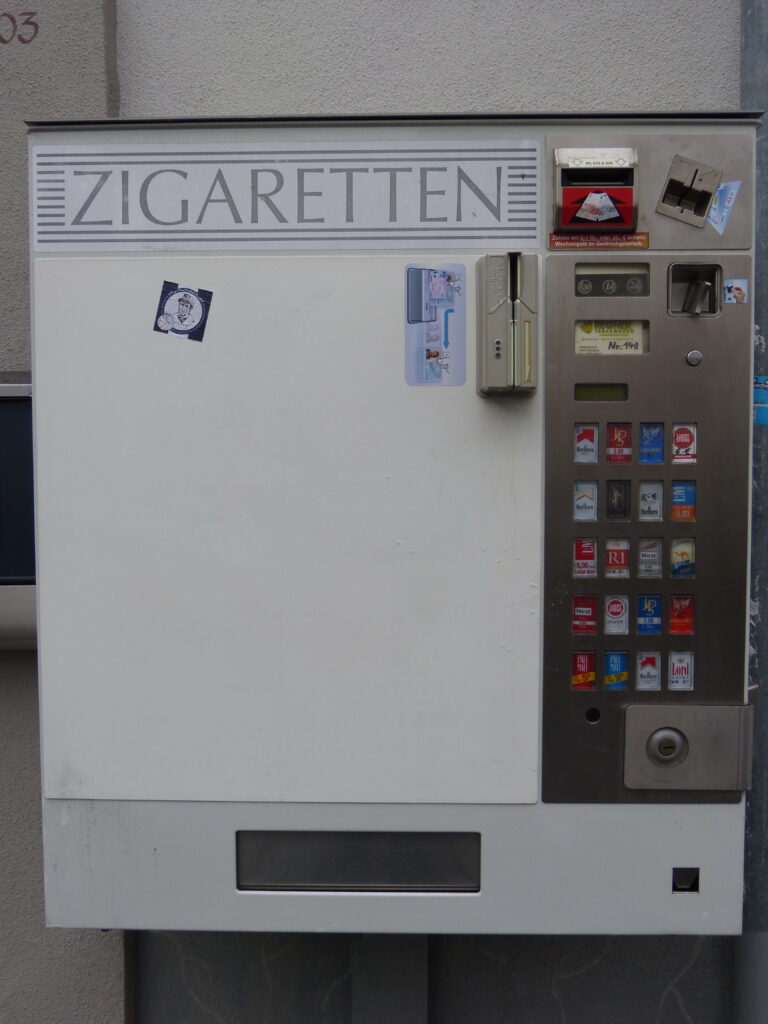
Yup, it’s very common to see a cigarette machine on a street corner. If you look under the letter N in “Zigaretten” on the machine, you’ll see a slot to swipe an ID card because you have to be 18 to purchase cigarettes this way. Just so interesting to me because you just don’t see these machines on the streets in the U.S.
So I took this next photo having no idea who Johannes Bückler was.
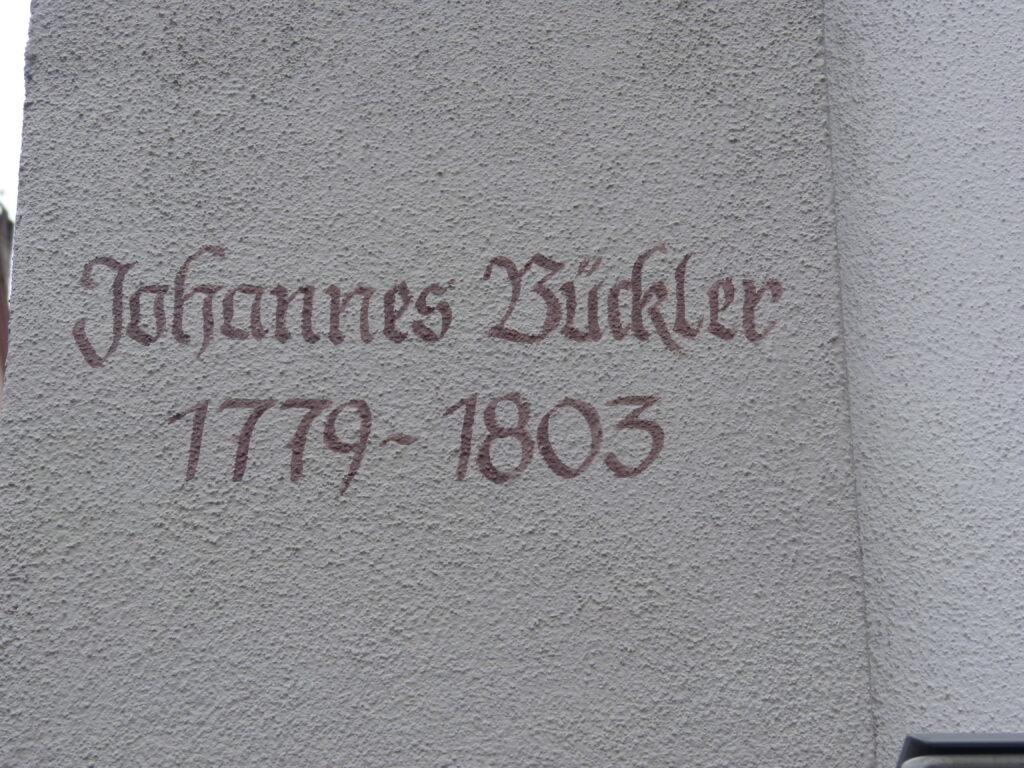
Turns out he was a famous outlaw who has been called the German Robin Hood. He was eventually caught and guillotined in Mainz, very close to where I live, in the year 1803. Over 40,000 people witnessed the execution.
Here is the house that had the name and dates you just saw above.
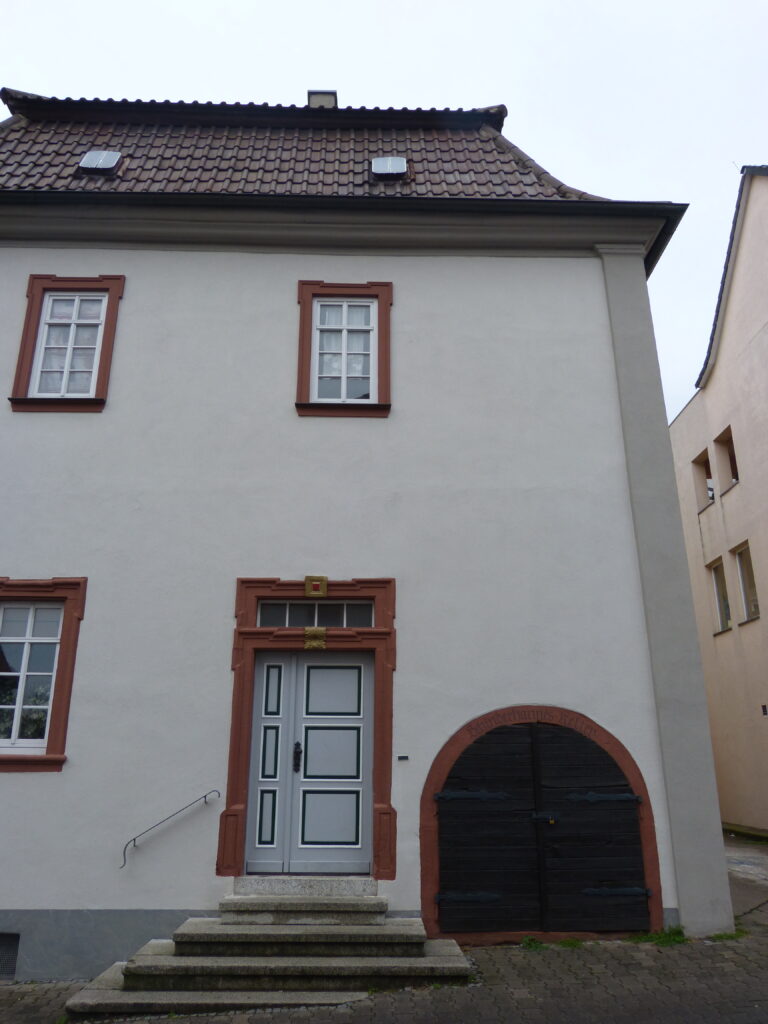
From what I can find, which is lots of bad translations of German articles, Herr Bückler may or may not actually have lived at this house in Lorsch but the current owner is sticking to his story. Here’s a close-up of the doors you see on the right side of the photo above.
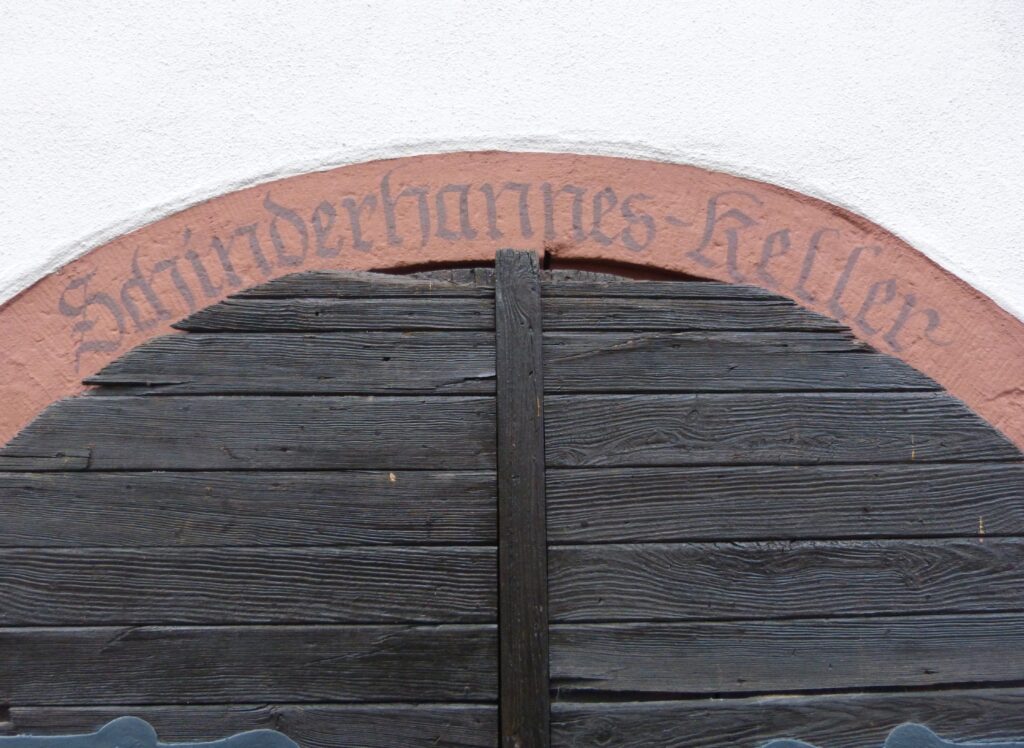
Bückler’s nickname was Schinderhannes. I’m not quite sure what that means but it seems to have something to do with his family’s profession of flaying. Bückler himself was an apprentice tanner at one time who was arrested for stealing calf skins. As you can see above, it says Schinderhannes Keller (Keller is the German word for cellar or basement) above the door.
Here we are back at the Saint Nazarius church and this building is the rectory.
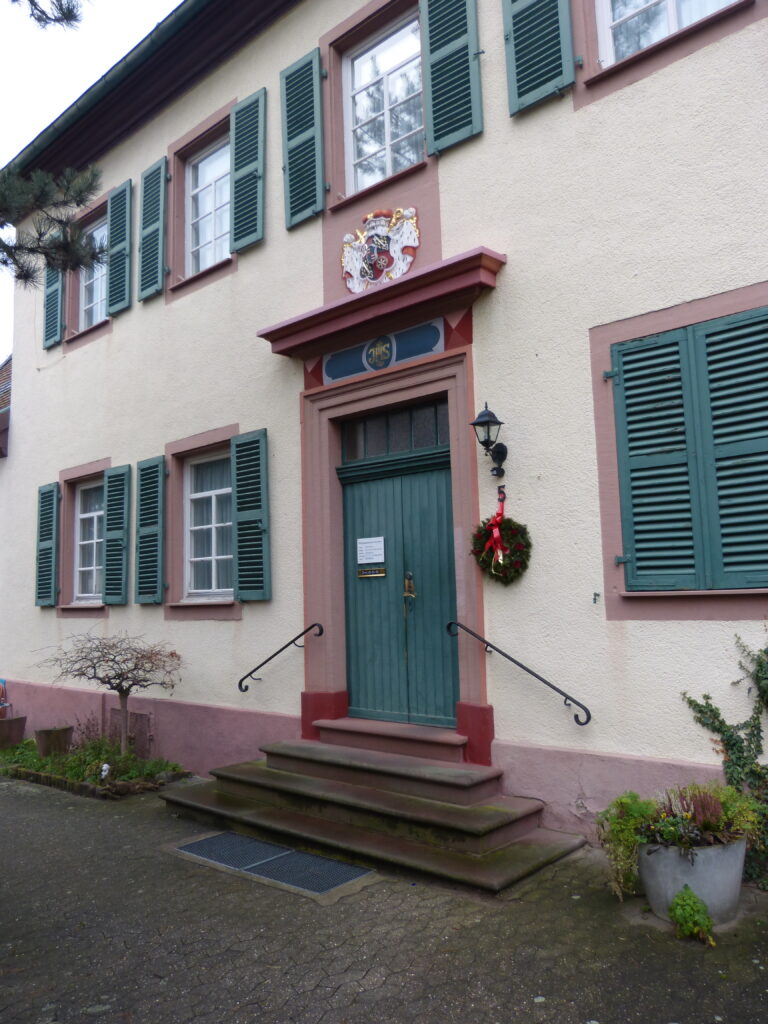
It was built in 1776. Over the doorway, just below the window, is (according to the sign there) the coat of arms of the Elector and Archbishop Frederick of Erthal with the symbol for the diocese of Mainz (Mainz wheel) and the Bishopric of Worms (St. Peter’s key).
So, I don’t know about you but I think there was enough in this town to warrant the TI investing in a little information for tourists who are going there anyway to see the UNESCO sight. And I hope you enjoyed reading about Lorsch because this is probably the longest it’s taken me to write any of my blog posts due to all the translation and research I had to do. Maybe I should hire myself out to the TI.
Oh, and by the way, if you decide to go to Lorsch make sure you don’t end up going to a similar-looking and -sounding town like Lorch. We had previously been to Lorch and when I read about the abbey I thought huh, I wonder why we didn’t see it when we were in Lorch last year? That would be because it was a different town. A lot of German towns have names that either sound similar or are spelled similarly, which can confuse non-German speakers. For example, there is a Hamburg in Germany and there is also a Homburg in Germany. They are nowhere near each other (about 6 hours apart) so you don’t want to mix up one little letter and make a mistake like that.
The day after we went to Lorsch, we visited another UNESCO site in Maulbronn.
The site there is a Cistercian monastery complex and it is the best-preserved one north of the Alps. It is over 850 years old. The author Herman Hesse attended the seminary there for a short time as a young teenager.
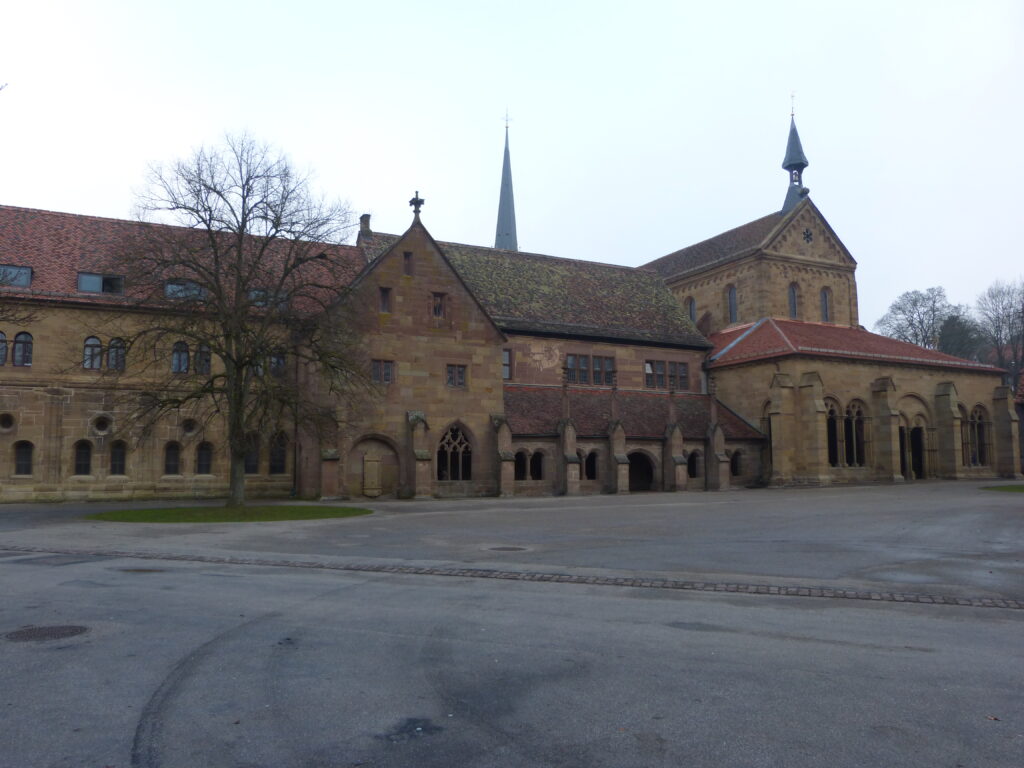
You can stroll around the complex for free, but if you want to go into the monastery church and see any of the other buildings around it or the cloister garden, you have to pay an entry fee. You can also rent an audio guide that explains the different sites, so we did that.
Aside from the church and its connected buildings, this was the biggest structure we saw in the complex.
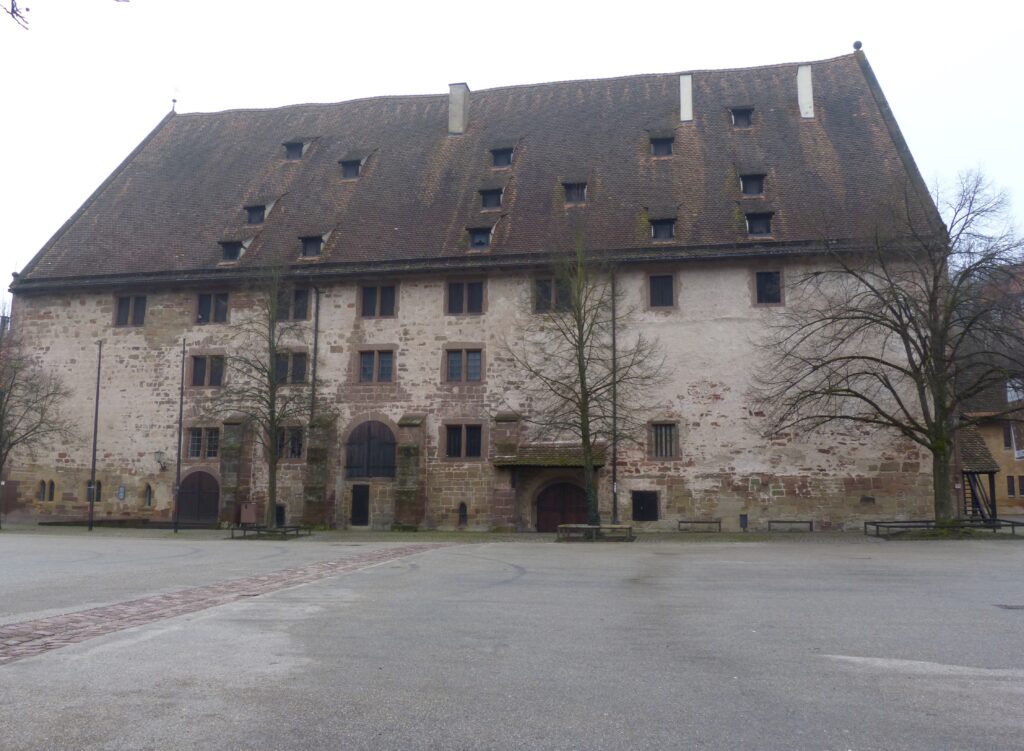
It was used for storing grain.
This is the vestibule of the church, called the Paradies (paradise).
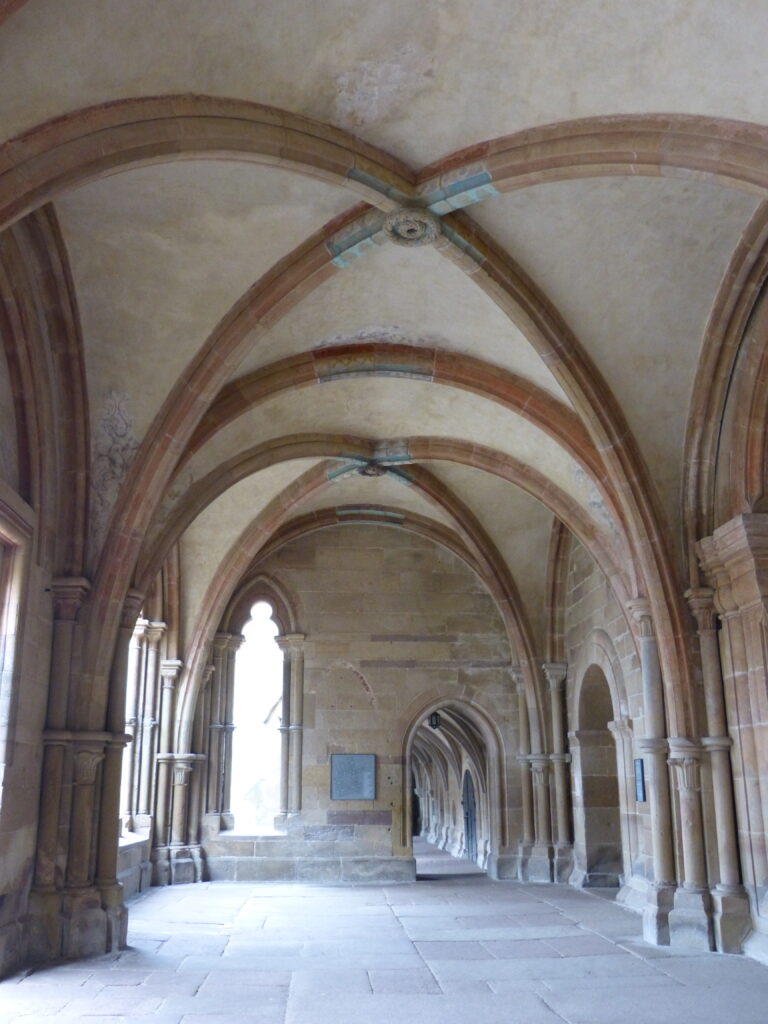
It’s called that because there was a custom of painting scenes from the fall of Adam and Eve from Paradise in church vestibules. Hardly any of the paintings at Maulbronn are visible any more, though.
Inside the church is this crucifix.
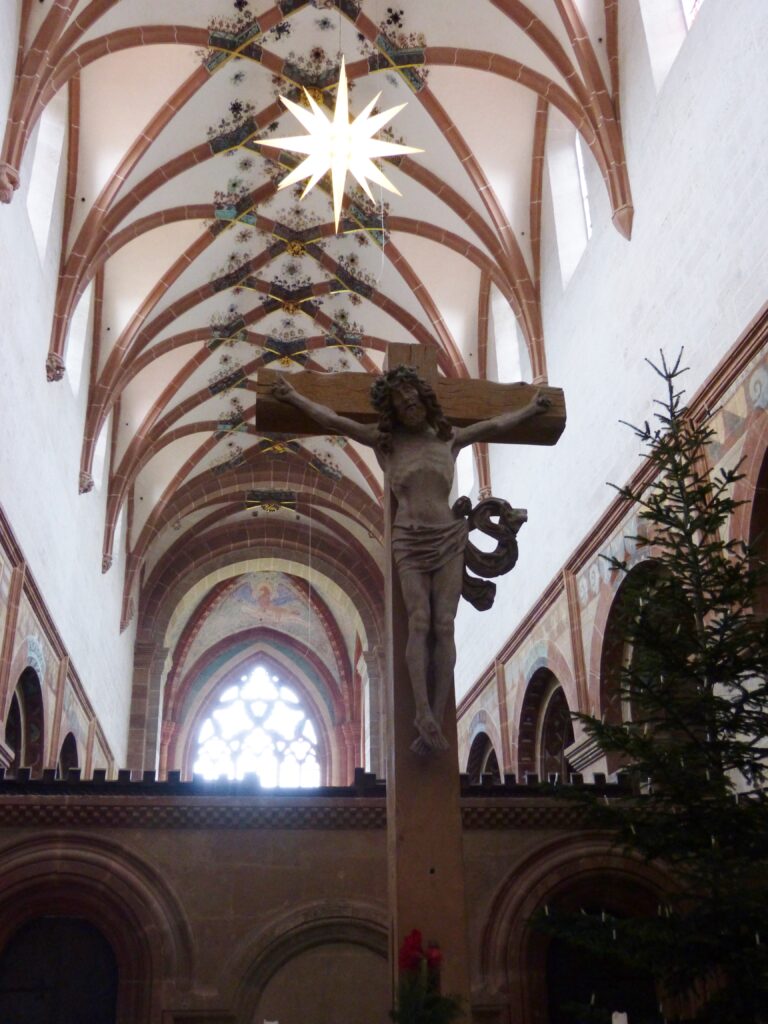
The cross looks like it’s made of wood, but it was carved from stone.
The carvings at the ends of the choir stalls were quite elaborate.
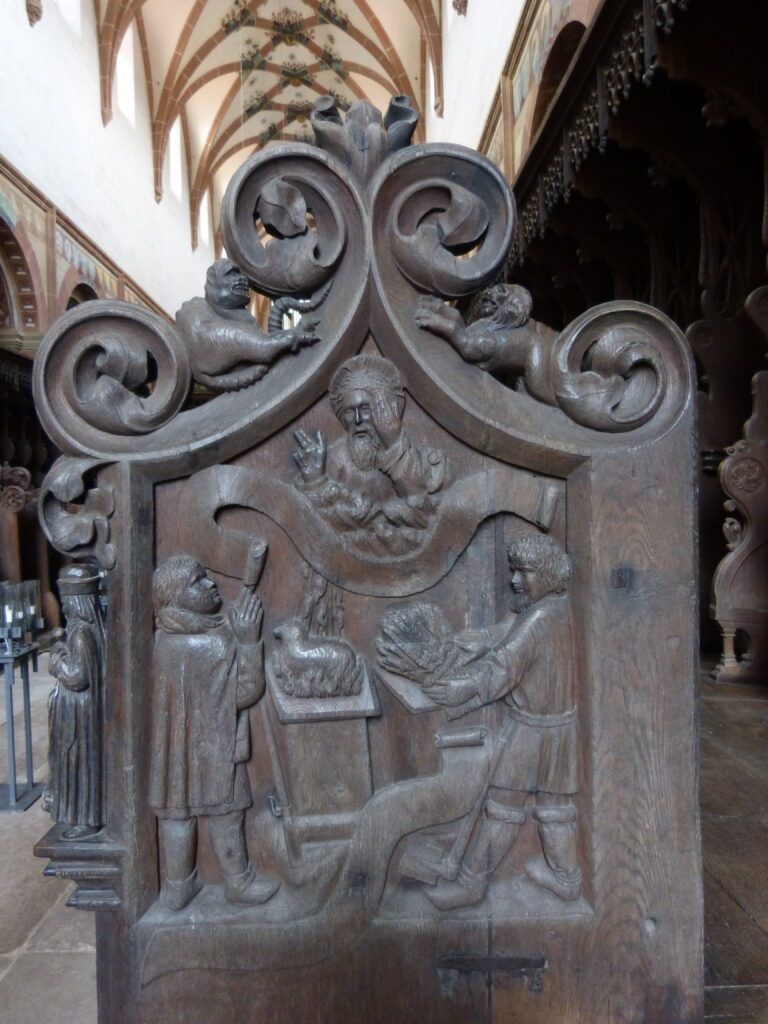
The stalls are where the monks of the monastery would sit and stand to pray and sing.
Here you can see two actual stalls with little benches in them.
Unfortunately the cloister area was under construction and we couldn’t get a really good look at it.
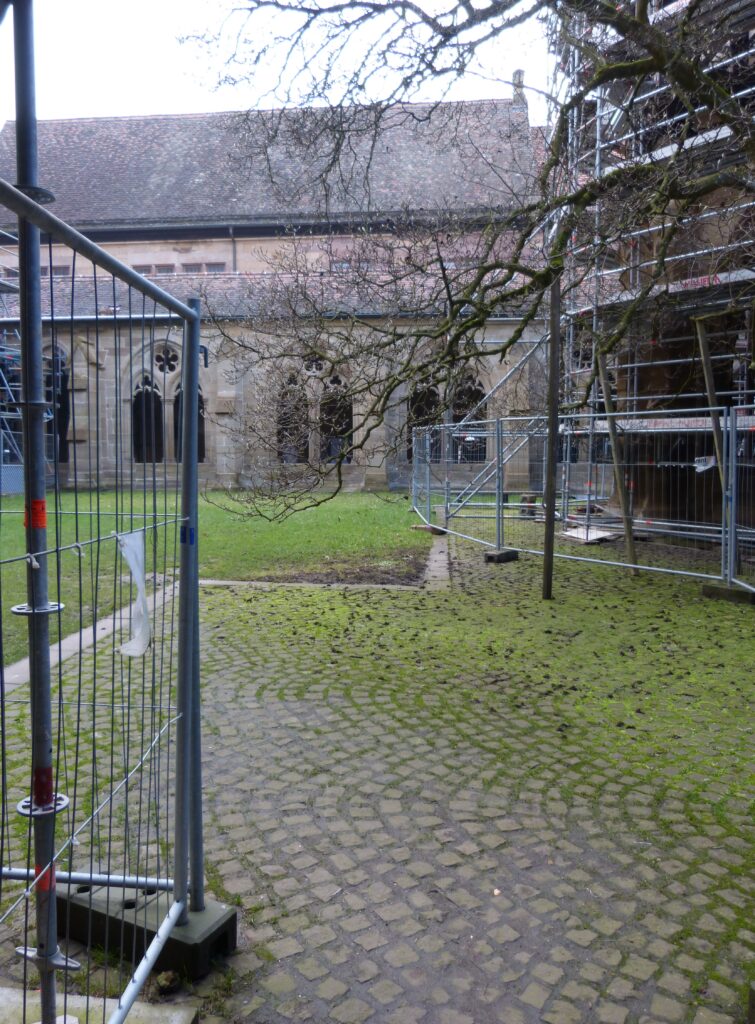
(It occurred to me that these UNESCO sites must be doing pretty well to be able to do all this renovation and maintenance!)
This room was called the Parlatorium.
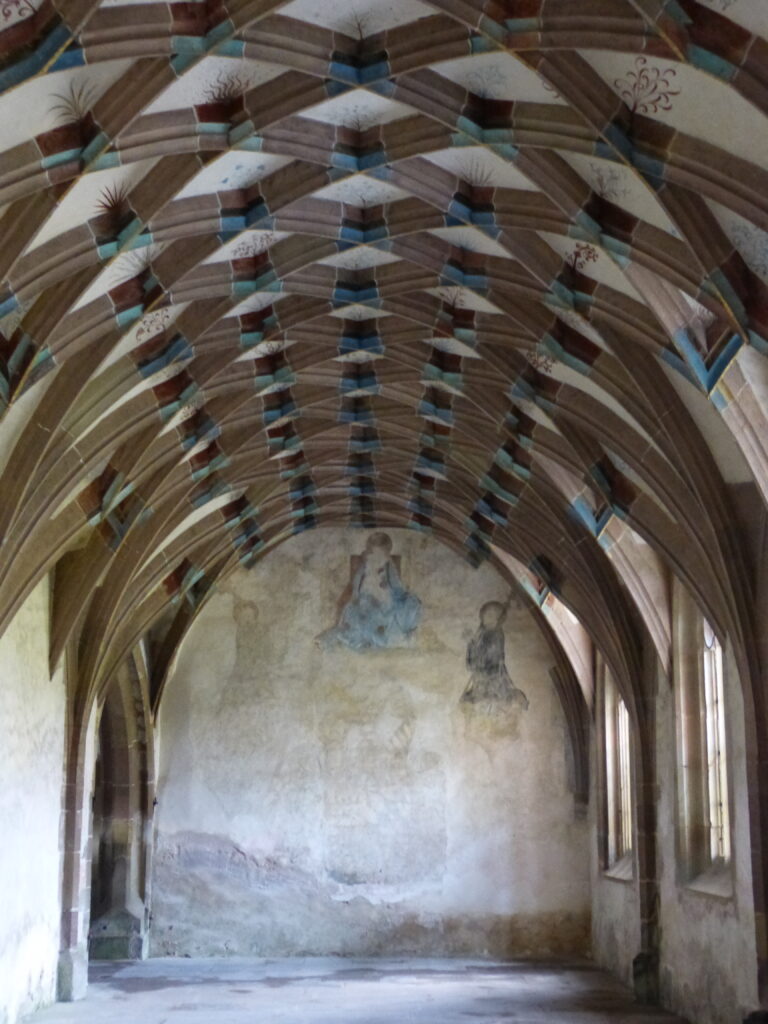
It was the only room in the monastery where the monks were allowed to speak. Notice the remnants of paintings on the far wall. I liked the ceilings too.
This is the fountain house.
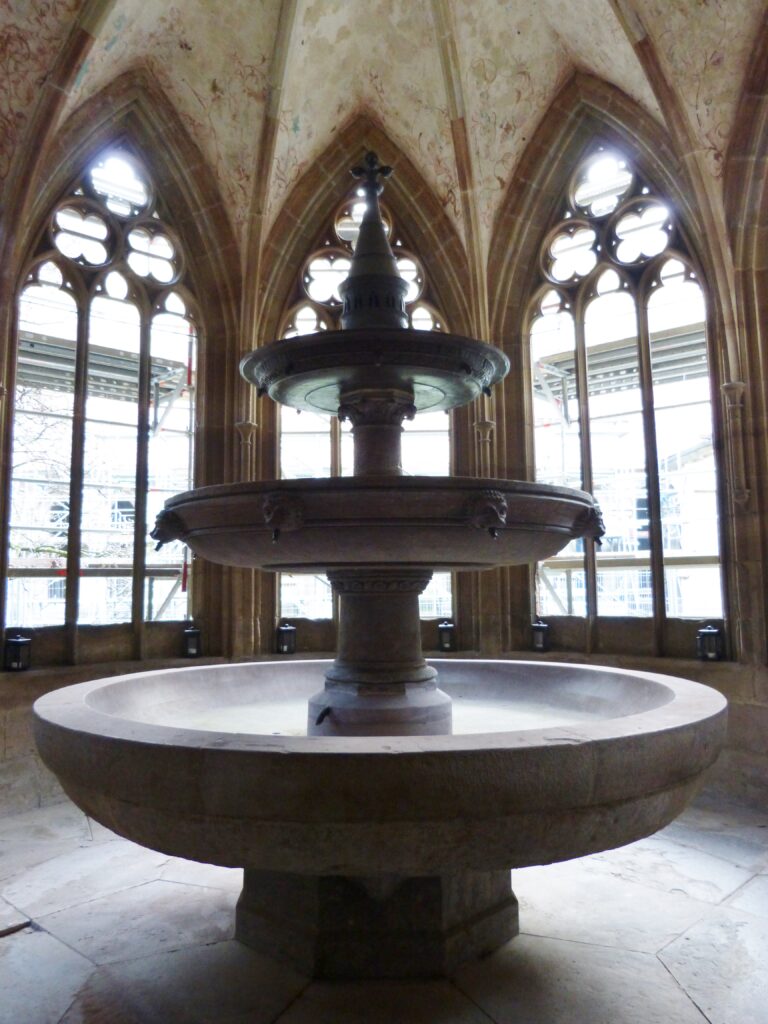
That fountain is where the monks would wash their hands before they took their meals. The fountain originally just consisted of the bottom part and was later added on to.
This is the monks’ refectory.
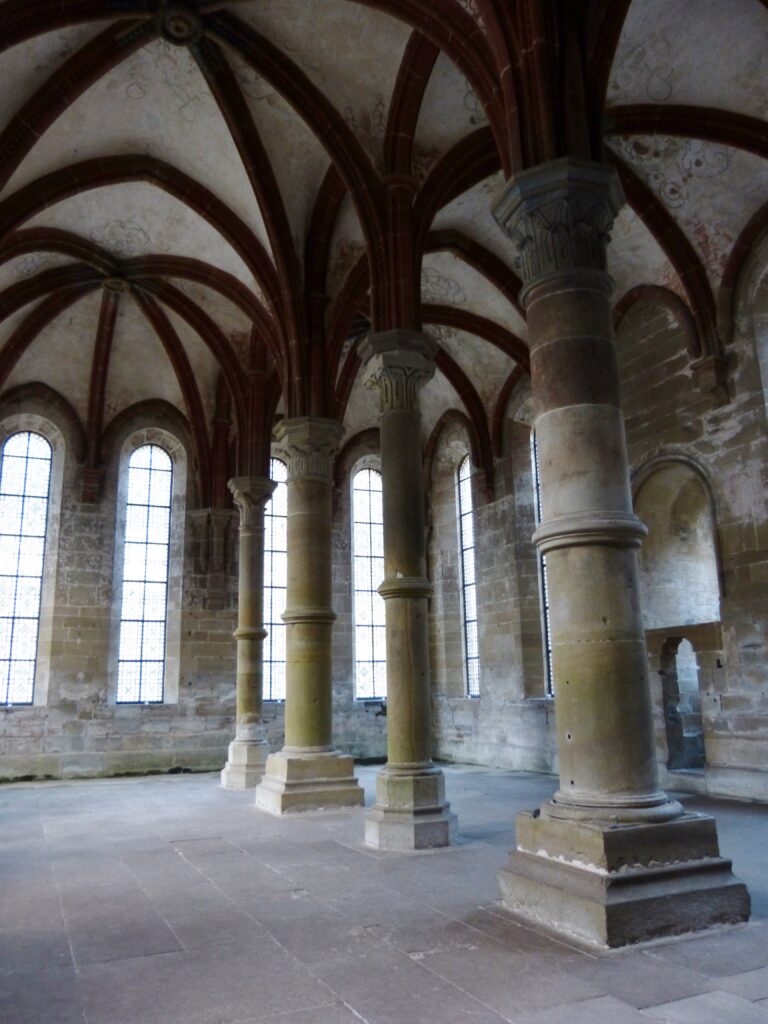
A refectory is basically a dining room, so you might be able to guess that this room was directly across from the fountain above where the monks washed up before eating.
One lucky monk got to speak during meals, and he would sit in this area.
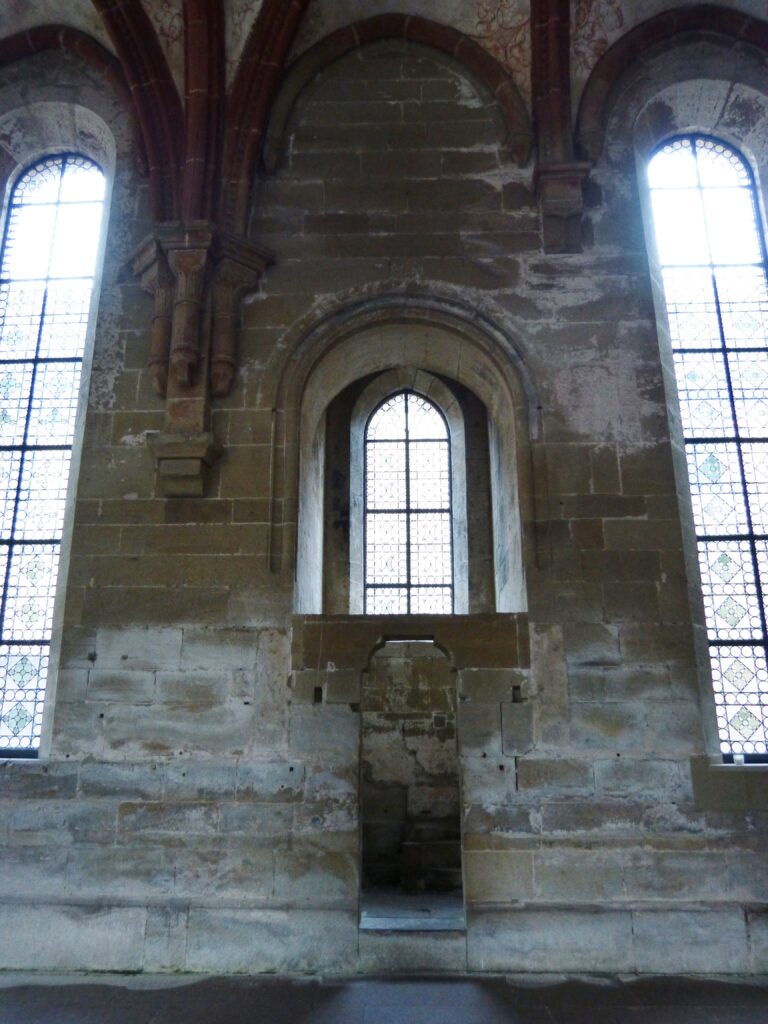
There were stairs inside that little opening so the monk who got to speak would be sitting higher than the other monks. He would read from the bible or other books.
This wall was between the refectory and the kitchen.
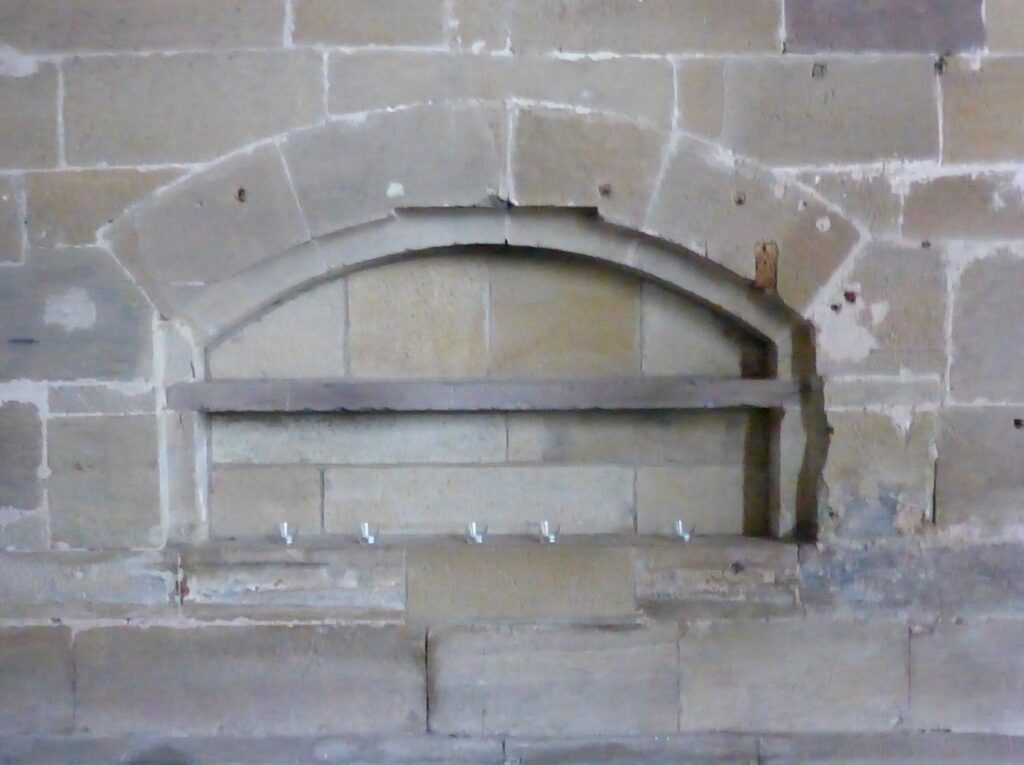
What you see there used to be an opening for passing the food through from the kitchen to the refectory.
At the end of the tour through the church, you end up in a room that’s a little museum. There was a lot of old stonework in there, including this balustrade.
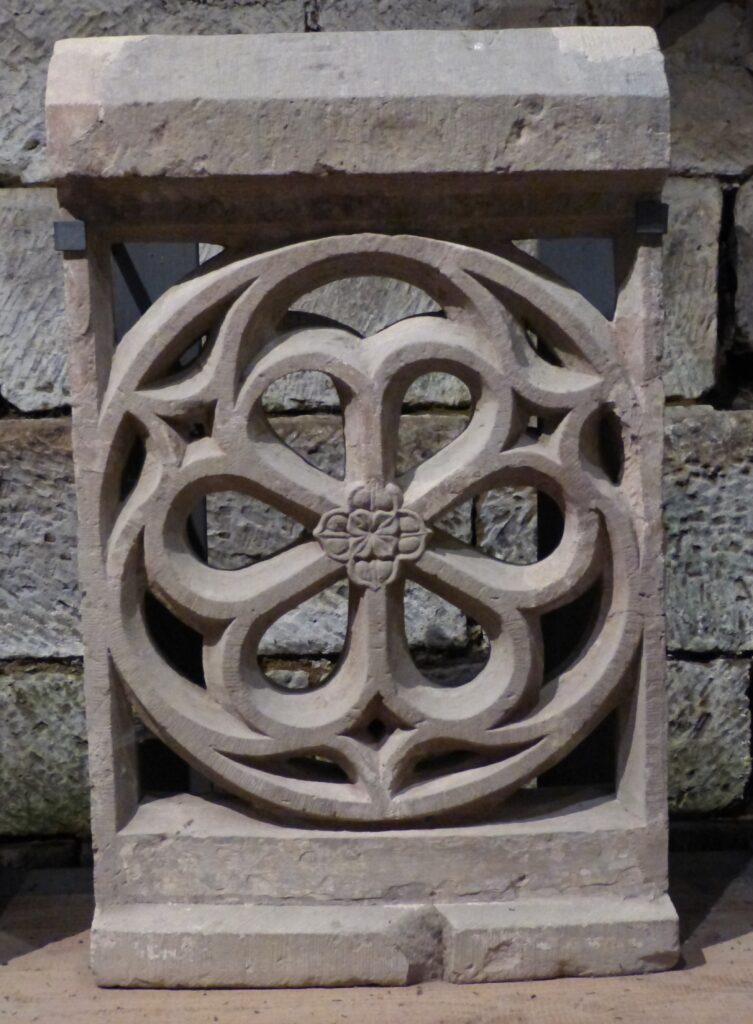
I will freely admit that although I’ve heard the word balustrade before, I didn’t really know what it was. If you don’t either, I’ll tell you. It’s “a railing supported by balusters, especially one forming an ornamental parapet to a balcony, bridge, or terrace.” That definition led me to look up the meaning of “baluster”, which you can read here
http://en.wikipedia.org/wiki/Baluster and see a visual that will make you say “Oh! I know what a baluster is!”
These are two nice-looking half-timbered buildings that are directly across from the church.
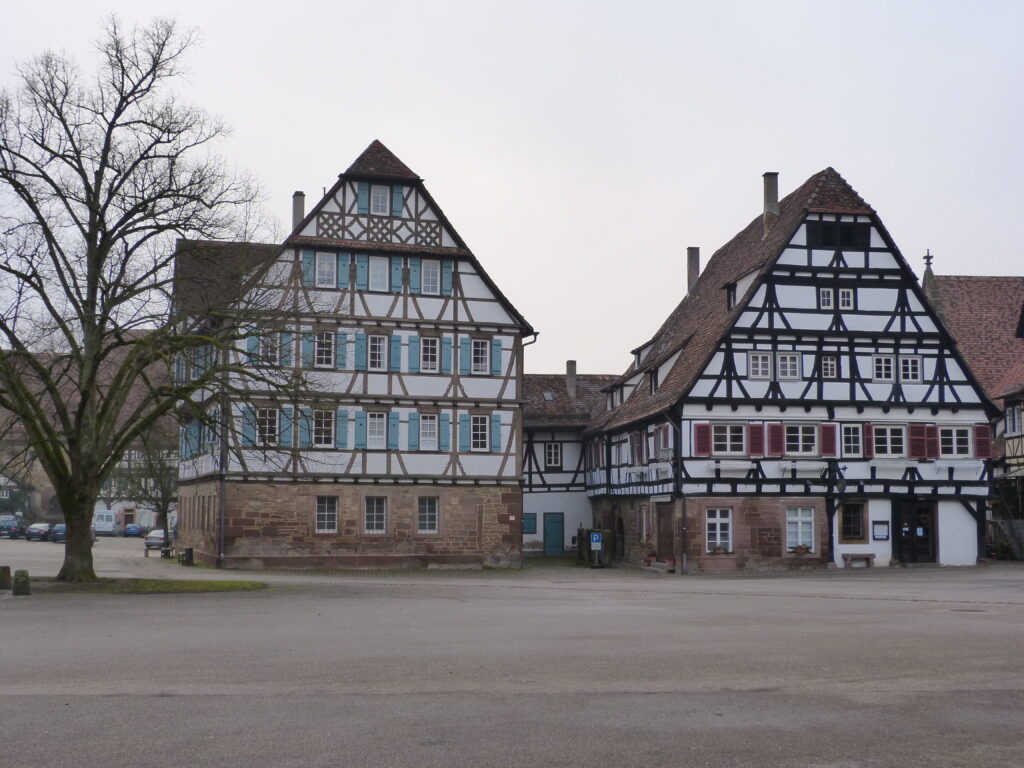
Note that they both have stone bases. The building on the right now houses a restaurant and it’s in the part of the complex where you can walk around for free.
Also in the free part of the complex is this stairway to a wall that you can walk along.
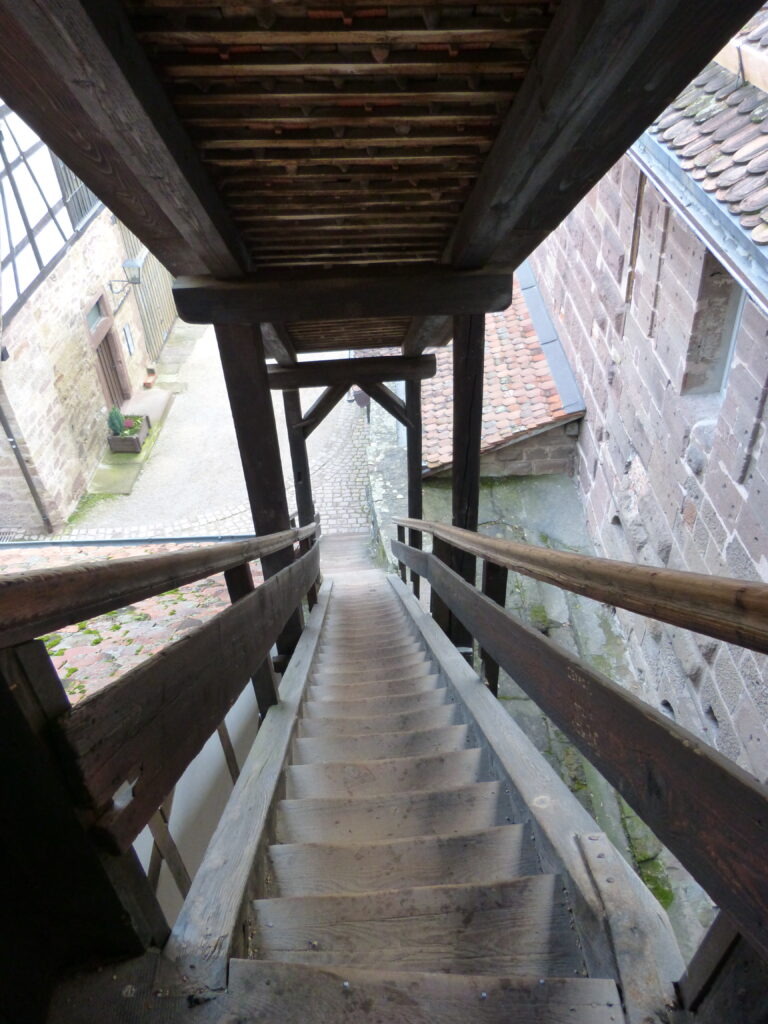
This is one of the views from the top of the wall and you can see one of the few remaining towers in the complex.
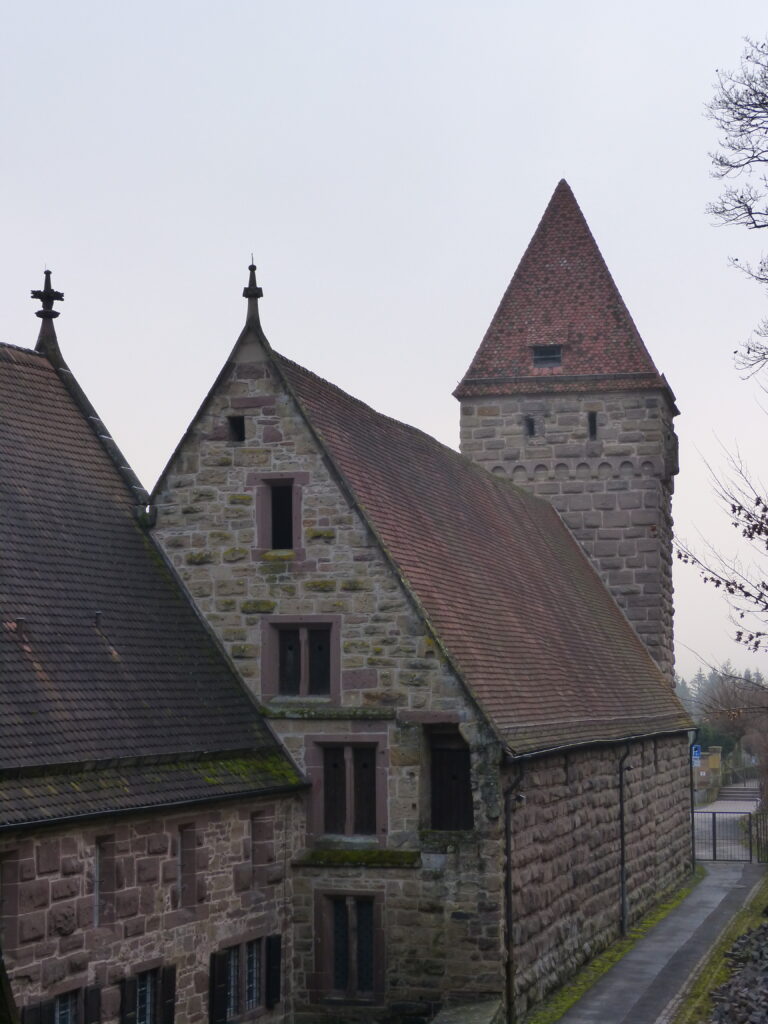
We didn’t walk along the wall because parts of it were very muddy and we had had enough slogging mud the previous weekend in France. We did see a sign for a café up there though, and there is also a lake nearby so I’m sure it’s a nice walk when it’s not muddy.
Here’s another nice-looking half-timbered building with a stone base.
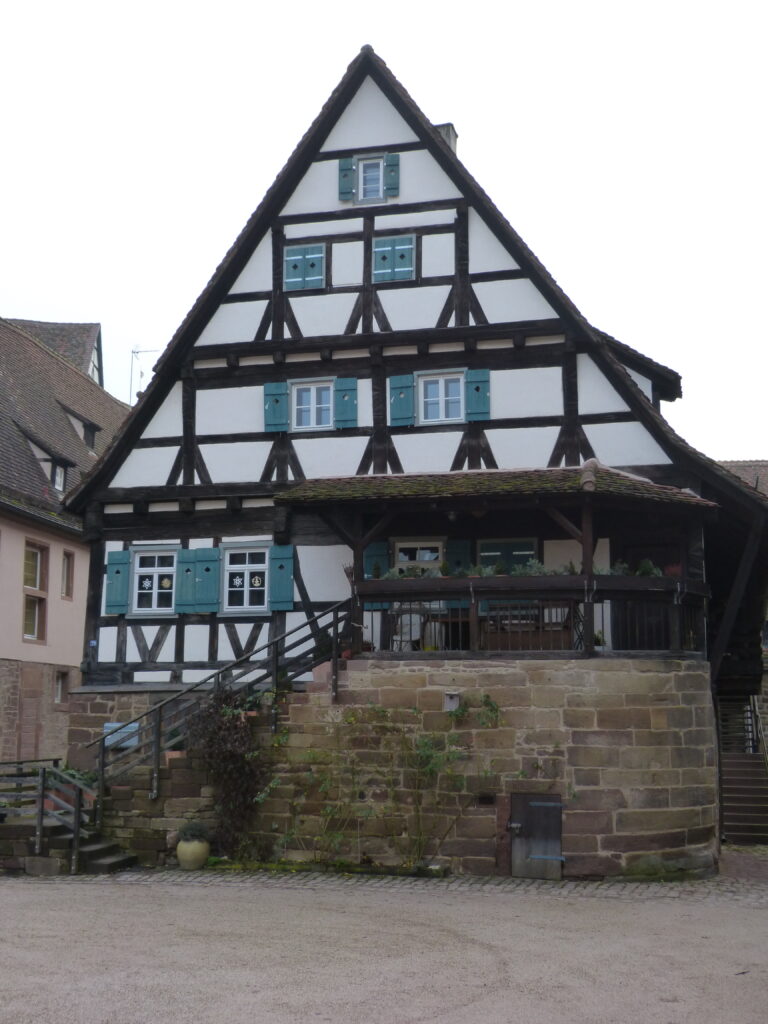
You’d think I’d be tired of looking at half-timbered buildings by now, but I’m not.
On the way back to the car, we got a nice view of the church and part of the complex.
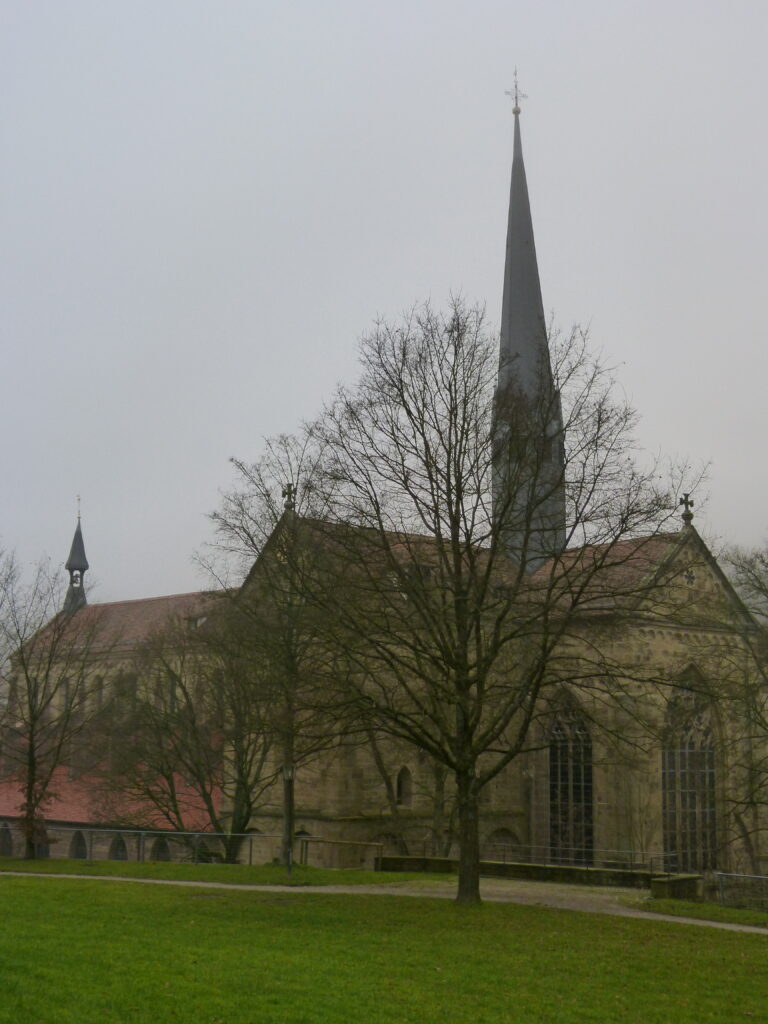
And here’s another of the remaining towers with a glimpse of the church and complex.

Despite the abbey in Lorsch being closed and the cloister at Maulbronn being closed and the skies being gray and the ground being muddy, we had a good weekend checking out the UNESCO sites. It made me to take a look at the sites in Germany that we have not yet seen and we are hoping to be able to check some of those out as well.

